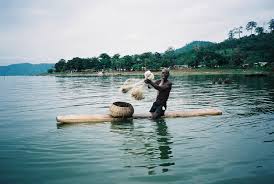
“A journey of a thousand miles begins with a cash advance” – anonymous
This week’s attraction, yet again, combines the mystery of myths and the beauty in nature into a beautiful blend that would excite not only tourists but people from all walks of life and endeavour.
This week, Hidden Treasures is taking you on a trip into the Ashanti region where culture is the order of the day. Join us as we visit Lake Bosomtwe, a spectacular sight that is characteristic of its home country, Ghana… Come along…
LAKE BOSOMTWE
Situated approximately 30km south of Kumasi, the capital of the Ashanti Kingdom, in a vast crater lies Lake Bosomtwi, the most expansive natural body of fresh water in Ghana. It is also the deepest, reaching a maximum depth of 80-100m, and 10.7km2 in diameter.
Some people believe that the lake was created by a volcanic activity while others say it was created by a falling meteorite that hit the area, causing a crater to be formed. However, piles of heavy rainfall over the years filled the crater with water causing the lake level to rise.
The lake’s water size and level varies according to particular seasons in question. There are times it overflows it banks and other times the water level could be close to a pond. The Lake houses varieties of fish which fuels one of the main occupations of the inhabitants of the surrounding villages.
Historic Accounts
Traditional Ashantis hold the believe that several years past, an Ashanti hunter named Akora Bompe, who hails from the town of Asaman, was chasing an injured antelope through the forest. Swiftly, the animal vanished into a small pond.
As if it was a design that this body of pond should save the animal’s life, the hunter never got the antelope; nonetheless he settled close to the water and went into fishing.
He is believed to have named the place “Bosomtwe”, meaning “antelope god”. The following centuries saw several wars about the lake as the Ashantis and the Akims both claimed the area to be theirs. Finally the Ashantis were victorious and secured Lake Bosumtwi for their kingdom.
Many fallen Ashanti warriors from Asaman were buried in a mass grave close to the lake. This place is called ‘Ekoho’ and farming was no allowed there. The Ashantis consider Lake Bosumtwi a god. He is believed to have been born on a Sunday, and the people celebrate the birthday of the lake in a special festival called Akwasidae.
Each village in the lake area has its own shrine or fetish grove. With the arrival of Christianity, some of the people lost their belief in those traditions, but nonetheless, many still worship these gods for help in bad times or against diseases.
Currently, there are about 23 000 people living in the 27 lake communities. Each village around the lake area has its own shrine with many visiting to look for spiritual help.
There is a stone at the lake side called Abrodwum Stone and believed to be the spiritual centre of the lake. Usually, whenever there is poor yield, it is considered a bad omen, thus sacrifices would have to be made.
This deed is undertaken in the presence of the Asantehene. In the ceremony, the cow’s innards are offered to the stone and the rest thrown into the water. It’s a spectacular sight to see the crowd rush into the water with cutlasses and axes to take their share of the meat.
Considering the above belief, Lake Bosomtwi is held sacred by Ashanti traditionalists, though the finer details of its exalted status are rather elusive. Some claim that Bosomtwi is where a deity called ‘Twi’ resides.
Others believe that it is visited by the souls of the departed on their passage to eternity. It is also the sacred water body of the Bosomtwi; one of five divisions in the matrilineal Nton system which the Asante and other Akans believe passes a father’s attributes to his children.
In former times, it was a taboo to touch the water with iron things, so the people never used conventional boats. Till date they move on the lake using the ‘padua’, a wooden plank that needs a lot of skill to be handled in the right way.
It must be admitted that it is not clear whether the crater in which Bosomtwi lies is volcanic in origin, was formed by a meteorite or a small pond. Either way, the lake is a beautiful spot, encircled by mountainous, thickly vegetated crater walls rising several altitudes. This presents ample opportunities for walking, birding, fishing, and canoeing.
Visitor Account
Once I got through classes and my internship during the week, including my last lecture of college, I set off with my friend Hannah for Kumasi, the second biggest city in Ghana.
We walked through the middle of the largest open market in West Africa, Kejetia market! We bought some amazing print fabric and walked down the railroad tracks through the heart of this intricate maze of foods, spices, and all sorts of crazy things (including dried chameleons for traditional medicine).
The next day, we headed 35km outside of Kumasi to spend the night at Lake Bosomtwe! This lake was made from a meteor that hit Earth over one million years ago and formed a creator surrounded by mountains that was then fed through a natural underground spring to form the lake.
It was so beautiful and peaceful there. We stayed at a gorgeous guesthouse, got to hold a piece of the meteor, and swam in the water, so fresh and clear. We enjoyed watching the flying birds and the traditional-style fishermen. We also got to take a one-hour canoe trip across the lake the next morning! The panoramic view of layered mountains was incredible.

























